“The man who trusts men will make fewer mistakes than he who distrusts them.”
– Camillo di Cavour, prime minister, Kingdom of Sardinia
I’m getting a bit behind on dinner posts, so I may throw these at you rapidly over the next couple of days. You’ll live. Let’s start back at the beginning of the month and our 150th year celebration of the unification of many of the various states and kingdoms that would eventually become Italy, into the Kingdom of Sardinia, or, at that point more properly known as the Kingdom of Piedmont-Sardinia. Either way, it gave license to play in the kitchen with some favorite Sardinian recipes.
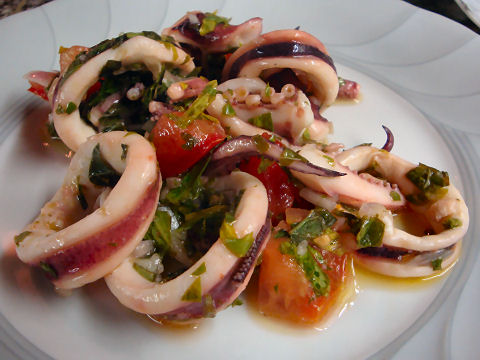
We began with a simple insalata di calamari – quickly blanched squid rings and tentacles, tossed with a bowl filled with tomatoes, garlic, celery leaves, basil, mint, shallots, olive oil, lemon, salt and pepper. You pick the proportions, it’s all good! Serve it room temperature – basil and tomatoes don’t stand up well to long refrigeration, so keep it in mind when it comes time to blanch the squid – you want it to have time to cool to room temp, but not sit there for hours and hours.
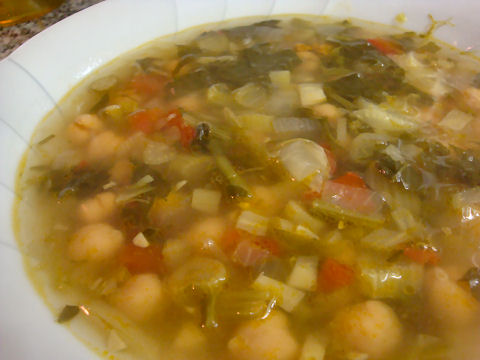
Combining two favorite chickpea based soups, one that simply combines them with saffron, the other with fennel, and we have our minestra di ceci con zafferano e finocchi. Sauteed onions, carrots and fennel in a little olive oil until starting to soften, then added chickpeas, freshly made chicken stock and saffron, let it all cook together for a bit, season to taste with salt and pepper. Serve and enjoy!
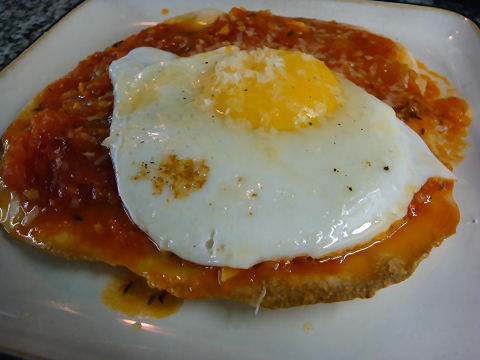
The only time I’ve ever tried pane frattau was at a little Sardinian spot here in BsAs. At the time, I assumed… well, actually, was told… that it was served the traditional way – a piece of crispy semolina flatbread, pane carasau or, carta di musica, on the bottom, topped with ravioli filled with cheese and herbs, and then a poached egg atop. But research into the dish points a very different, and much simpler direction, and I’ve played with it a few times in our classes until coming up with a version I like quite a bit. The flatbread is not left crispy, but rather slightly chewy, but soaking it in boiling hot water for a minute or so just before getting ready to serve, and because it’s made from semolina flour, as is most really good pasta, it softens to a sort of al dente round of thick pasta. It forms the base, atop which is a ladleful of a simple tomato sauce made from crushed plum tomatoes, onion, garlic, finely shredded carrot, and thyme, and then the whole thing is topped with a fried egg and grated pecorino cheese. Either approach, it’s an unusual and delicious dish.
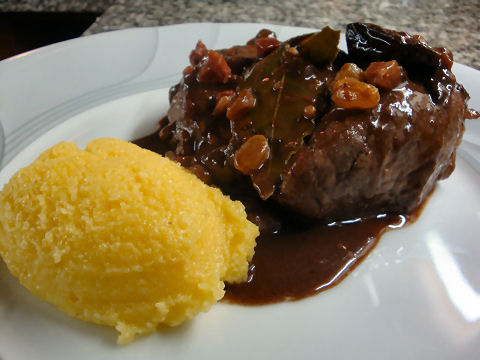
Traditionally a holiday dish, bistecchine di maiale (well, usually not made with pork but wild boar, cingiale), is a slow cooked steak of pork shoulder in what one of our guests referred to as “Italian mole” – not really, other than it happens to include some bitter chocolate in the mix, but I understand (it also makes the mistaken assumption that moles are chocolate based, when actually very few of the different versions are). Saute finely chopped bacon in a little olive oil then add and brown the steaks. Meanwhile, reduce some red wine vinegar in a pot, add yellow raisins, pitted prunes, bay leaves, bitter chocolate, and some sort of aromatic spice (usually nutmeg or cinnamon or both – I use mace). Sprinkle the steaks with a little flour and let that lightly toast, flipping the steaks a couple of times. Pour the reduced vinegar and fruit sauce over, bring to a simmer and let cook for 10-15 minutes, turning the steaks a couple more times to absorb the sauce evenly. Served with polenta and absolutely delicious!
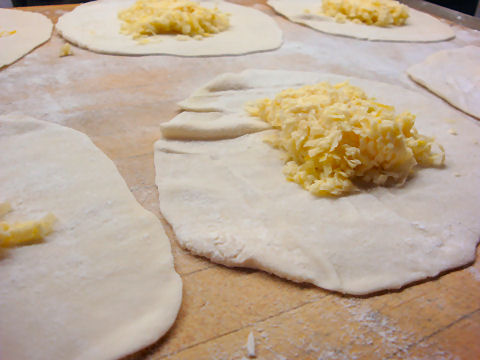
This is a killer dessert – simple, unexpected, and amazingly good. They’re called seadas. The dough is a simple flour, margarine and water one (or use lard, but not butter, the texture comes out wrong). The filling, a mix of grated pecorino cheese, grated lemon and orange zest, and grappa.
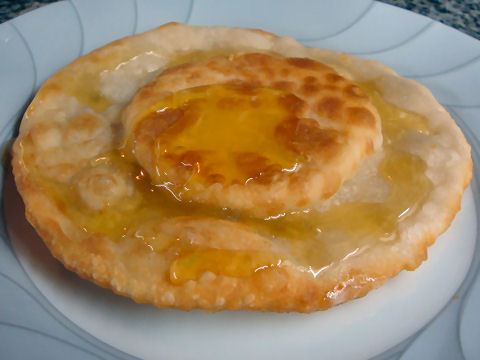
Form them into round ravioli shapes, cut with a fluted pastry wheel. Fry them in olive oil. Top them with good honey (chestnut honey is traditional). Serve. Sleep happy.
For the insalata di calamar, would that be all raw ingredients besides the flash cooking of the squid?
Yes, though I tossed them with the squid while it was still piping hot and then let it all sit until cooled to room temp.
Fixed the insalata di calamari for lunch and it was so good. Thank you for sharing this with us.
You’re welcome, glad you enjoyed it!
[…] probably make a chicken version of our Sardinian bistecchine dish, or maybe a chicken version of Felipe Rojas-Lombardi’s rabbit and chocolate […]
[…] a twist on one of my favorite Sardinian recipes, bistecchine di cingiale, made with duck breast instead, and for the dried fruits, just apricots instead of raisins and […]